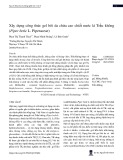
* Corresponding author.
E-mail address: saba.hadidi@yahoo.com (S. Hadidi)
© 2020 Growing Science Ltd. All rights reserved.
doi: 10.5267/j.ccl.2020.2.002
Current Chemistry Letters 9 (2020) 161–170
Contents lists available at GrowingScience
Current Chemistry Letters
homepage: www.GrowingScience.com
A theoretical investigation of the flurbiprofen methyl ester isomerization as the
main step in the photopreparation of anti-inflammatory medicine (S)-flurbiprofen:
A DFT study
Saba Hadidia*, Mohammadsaleh Norouzibazazb,c and Farshad Shiria
aDepartment of Inorganic Chemistry, Faculty of Chemistry, Razi University, Kermanshah, Iran
bNano Science and Technology Research Center, Razi University, Kermanshah, Iran
cDepartment of Organic Chemistry, Faculty of Chemistry, Razi University, Kermanshah, Iran
C H R O N I C L E A B S T R A C T
Article history:
Received October 8, 2019
Received in revised form
November 21, 2019
Accepted February 18, 2020
Available online
February 18, 2020
In order to investigate the isomerization and conversion mechanism of the advantageous and
widely used nonsteroidal anti-inflammatory medicine flurbiprofen, the hybrid density
functional theory was applied. According to the results, the rearrangement reaction of (R)-
flurbiprofen to its (S)-enantiomer happens in a [1,3]-hydrogen shifts with inversion of
configuration at chiral center C14. From the calculated energies, it can be understood that the
rate-limiting step in the flurbiprofen isomerization is the excitation of (R)-flurbiprofen methyl
ester in its initial form to the first excited singlet state S1 at λ=243.91 nm. we studied this
process by scanning the C14-H17 distance for the excited singlet to get more information about
the process of isomerization occurring upon excitation. The results of calculations
demonstrated that the isomerization process should pass through a ~71 kcal/mol barrier. The
(S)-flurbiprofen methyl ester is more photostable than its related (R)-enantiomer. This issue
can be attributed to the -1.50 kcal/mol of thermodynamic stability of the (S)-flurbiprofen
methyl ester.
© 2020 Growin
g
Science Ltd. All ri
g
hts reserved.
Keywords:
Flurbiprofen
R/S isomerization
DFT calculation
Conversion mechanism
1. Introduction
Flurbiprofen, racemic 2-(2-fluoro-4-biphenyl) propionic acid is a famous orally effective
nonsteroidal anti-inflammatory drug (NSAID), which is widely used for the treatment of pain due to
rheumatoid arthritis, osteoarthritis, ankylosing Spondylitis, and acute gouty arthritis.1, 2 This medicine
has attracted a lot of attention because of its important advantageous properties. The analgesic effects
of this medicine are mainly attributed to the inhibition of the enzymatic activity of cyclooxygenase,
which leads to the suppression of prostaglandin synthesis.3-5 Due to this analgesic effects, flurbiprofen
can also be utilized in short term alleviation of post-operative pain in dental patients.5 Experiments
indicated that flurbiprofen and other NSAIDs can reduce the relative risk of colorectal cancer after two
or more years of continuous use.6, 7 Several investigations revealed that flurbiprofen like other clinically
significant medicines shows stereoselectivity in action and disposition.8-11 It means that different

162
enantiomers have various impacts on pharmacokinetic processes.12-14 Like other NSAIDs, such as
ibuprofen and fenoprofen, the drug with a chiral center, can inhibit cyclooxygenase only by its (S)-
enantiomer. Another enantiomer of flurbiprofen ((R)-flurbiprofen) exhibits minimal inhibition
cyclooxygenase activity.15 Unlike the other NSAIDs,16 flurbiprofen does not undergo configuration
inversion and the (R)-flurbiprofen is not epimerized to the (S)-enantiomer in humans.17 Enzymes have
a significant role in determination the enantiomers of organic synthesis. One of the enzymes that can
catalyze the reactions in aqueous solvents in highly enantioselective level is Candida rugosa lipase
(EC 3.1.1.3).18, 19 The enzymes not only are able to hydrolase soluble and insoluble substrates in
aqueous conditions, but also can be used widely in organic synthesis.20 The current work aims to
investigate the isomerization mechanism of racemic flurbiprofen by employing the quantum chemical
method. In this study, in order to overcome the theoretical 50% limit in the resolution of racemic
medicines, the facile conversion of racemic flurbiprofen into its (S)-enantiomer by dynamic kinetic
resolution (DKR) conditions was employed.19 The most common transformation-catalyzing lipases
were employed to study the kinetic resolution of racemic flurbiprofen.21 As illustrated in Figure 1, the
computations were carried out by considering esterification of flurbiprofen to relating flurbiprofen
methyl ester.
Fig. 1. Fisher esterification of racemic flurbiprofen in methanol at 40 °C for 5 h
2. Results and discussion
(R)-flurbiprofen undergoes an energetically favorable second ground state rearrangement to
generate (S)-flurbiprofen (Fig. 2).
Fig. 2. R/S-flurbiprofen enantiomers
The process route leading from (R)-flurbiprofen to (S)-flurbiprofen corresponding to the inversion
of stereochemistry at C14 have been identified.22 The reaction pathway of connecting (R)-flurbiprofen
methyl ester to (S)-flurbiprofen methyl ester is illustrated in Fig. 3 with details in Table 1. The used
relative Gibbs free energies are also listed in Table 2. Based upon this pathway, the R isomer undergoes
inversion of the stereochemistry or retention of configuration to generate the (S)-flurbiprofen or
reformation of the primary (R)-flurbiprofen methyl ester. The full geometry optimizations along this
reaction pathway were carried out at the DFT level by employing the PBE0 level of theory.16 The
calculations result depicted that the energy of (R)-flurbiprofen methyl ester is 1.50 kcal/mol higher than
(S)-enantiomer. The first step in the isomerization of flurbiprofen is the excitation of flurbiprofen
methyl ester in its initial form to the first excited singlet state S1 since the symmetry of [1,3]-hydrogen
shift from C14 to O18 is forbidden.23-25

S. Hadidi et al./ Current Chemistry Letters 9 (2020)
163
Fig. 3. Relative Gibbs free energy (in kcal/mol) diagram for the photochemical isomerization of
flurbiprofen methyl ester in aqueous solution
Table. 1. Bond length (in Å) for the photochemical isomerization of flurbiprofen methyl ester in
aqueous solution
Parameter Critical structure
R R* TS1 RI RI* TS1' TS2 S
C3-C14 1.521 1.521 1.472 1.477 1.477 1.472 1.48 1.519
C14-C16 1.529 1.529 1.531 1.513 1.513 1.531 1.516 1.527
C14-H17 1.093 1.093 1.57 - - 1.57 1.575 1.09
C14-C15 1.517 1.517 1.445 1.35 1.35 1.445 1.448 1.517
C15-O18 1.219 1.219 1.288 1.36 1.36 1.288 1.286 1.217
C15-O19 1.331 1.331 1.295 1.349 1.349 1.295 1.293 1.336
As is evident from Fig. 4, the UV spectrum indicated that the first vertical S1 excitation (HOMO to
LUMO) occurs at λ=243.91 nm, with oscillator strength f=0.5776 and one at λ= 234.45 nm, with
oscillator strength f=0.2194. This finding is in complete agreement with the orbitals demonstrated in
Fig. 5 which shows that the excitation is of π → π* transition nature. Furthermore, an additional peak
with lower oscillator strength (f=0.0140) was observed at λ=233.99 nm, assigned to HOMO-1 to the
LUMO.
Table. 2. Relative Gibbs free energy (in kcal/mol) for the photochemical isomerization of
flurbiprofen methyl ester in aqueous solution
Critical structure ΔG Critical structure ΔG
R 0 RI* 100.23
R* 117.22 TS1' 70.94
TS1 70.94 TS2 71.64
RI 10.83 S -1.50

164
200 220 240 260 280 300
0.0
2.0x10
4
4.0x10
4
6.0x10
4
8.0x10
4
1.0x10
5
1.2x10
5
1.4x10
5
Wavelength nm
Absorbance (oscillator strength)
Fig. 4. TD-PBE0/6-31++G(d,p) computed absorption spectra in the range 200-300 nm of the (R)-
flurbiprofen methyl ester (black) and (E)-2-(2-fluoro-[1,1’-biphenyl]-4-yl)-1-methoxyprop-1-en-1-ol
(red)
As illustrated in Fig. 3 near the (R)-flurbiprofen methyl ester geometry, a transition state, TS1
corresponding to C14-H17 bond breakage has 70.94 kcal/mol higher energy than the optimized ground
state (R)-flurbiprofen methyl ester. Since this process involves the migration of H17 from C14 to O18
is considered as a [1,3] Hydrogen shift.26 The Intrinsic reaction coordinates (IRC) were calculated at
the PBE0 level to authenticate the transition state.
Fig. 5. TD-PBE0/6-31++G(d,p) computed orbitals of the (R) and (S) flurbiprofen methyl ester and
(E)-2-(2-fluoro-[1,1’-biphenyl]-4-yl)-1-methoxyprop-1-en-1-ol
It can be concluded from the IRC calculations that this transition state leads to (R)-flurbiprofen
methyl ester in one direction and to an E isomer region corresponding to a 1-en-1-ol in the other. In

S. Hadidi et al./ Current Chemistry Letters 9 (2020)
165
addition, we used the similar calculation method to optimize the intermediate (E)-2-(2-fluoro-[1,1'-
biphenyl]-4-yl)-1-methoxyprop-1-en-1-ol, where the methyl group is twisted by about 90°
counterclockwise, relative to (R)-flurbiprofen methyl ester. Fig. 6. displays the optimized structures of
both reactive intermediate (RI) and (R)-flurbiprofen methyl ester.
Fig. 6. The optimized structures and bond length (in Å) of (R)-flurbiprofen methyl ester and
intermediate (E)-2-(2-fluoro-[1,1’-biphenyl]-4-yl)-1-methoxyprop-1-en-1-ol
From the comparison of RI with TS1 and (R)-flurbiprofen methyl ester, it can be seen that there are
some bond length changes in geometries. The obtained results clearly demonstrate the elongation of
the C15-O18 bond length (corresponding to hydrogen transfer) from 1.219 Å in the R ester to 1.287
and 1.360 Å in the TS1 and RI respectively. This elongation is the most important structural change for
the TS1 and RI. Aso, the H17-O18 distance changes from 2.538 Å in initial R isomer to 1.221 Å in the
TS1 and finally to 0.968 Å in RI with a calculated bond advancement (l) of 0.78.27, 28 In addition, the
C14-C3 bond length reduced from 1.525 Å in the R ester to 1.472 and 1.477 Å in the TS1 and RI
respectively. Further, C14-C15 bond length is also reduced from 1.517 Å in the R ester to 1.450 and
1.349 Å in the TS1 and RI respectively. Additionally, the C15-O19 bond length increased from 1.331
in the R ester to 1.349 Å in RI. Increasing the C15-O19 bond length and decreasing the value of C14-
C15 are attributed to the change of the resonance cycle with O18-C15-O19 to Ar 1-C14-C15.
Furthermore, this issue has been confirmed by the difference between the HOMO and LUMO of (R)-
flurbiprofen methyl ester and RI.29 The calculations revealed that due to the extending of conjugated
system in RI species, the HOMO–LUMO energy gap value reduced from 7.34 eV to 6.41 eV. The RI
possesses 10.84 kcal/mol higher energy than (R)-flurbiprofen methyl ester hence, the species has a
tendency to second H17 migration. The result of second migration of H17 from O18 to C14 along with
90° anticlockwise rotating of methyl group after passing through the transition state TS2 is generation
of stable (S)-flurbiprofen methyl ester.
As aforementioned, the symmetry of [1,3]-hydrogen shift from C15 to C14 is forbidden.23-25 Due to
this symmetry forbidden, the migration of H17 goes to completion by the excitation of RI to the first
excited singlet state S1. From the calculations, it can be understood that for RI species the excitation to
the S1 state occurs at 285.25 nm with oscillator strength f=0.8825. Moreover, several excitations were
observed at position 256.85, 249.14, 238.36, 227.45 and 225.25 nm with oscillator strengths f=0.0155,
f=0.0358, f=0.0010, f=0.0025 and f=0.1102, respectively. The results depicted that the RI singlet
excited system after passing through the TS2 results in formation of (S)- flurbiprofen methyl ester. The
calculations revealed that the TS2, that corresponds to the migration of H17 from C15 to C14 lies 71.64
kcal/mol higher in energy than optimized ground state (R)-flurbiprofen methyl ester. The
Stereochemistry of this reaction is dominated by internal methylene rotations which favor inversion of
stereochemistry at C14. The comparison of TS2 with RI and (S)-flurbiprofen methyl ester shows a
significant reduction of the C15-O18 bond length from 1.360 Å in the RI to 1.286 Å in TS2 and finally
to 1.217 Å at the product (S)-flurbiprofen methyl ester. In addition, both the C14-C15 and C14-C3 bond
lengths show gradual elongation of 1.350 Å in RI to 1.448 and 1.517 Å in TS2 and (S)-flurbiprofen
methyl ester for C14-C15, and for C14-C3 bond length from 1.477 Å in RI to 1.480 and 1.519 Å in
1 Aromatic











![Hướng dẫn giải chi tiết bài tập phân li, phân li độc lập: Tài liệu [mới nhất]](https://cdn.tailieu.vn/images/document/thumbnail/2025/20251204/lethu2868@gmail.com/135x160/84711764814448.jpg)



![Bài tập Đa dạng thế giới sống [kèm đáp án/ hướng dẫn giải]](https://cdn.tailieu.vn/images/document/thumbnail/2025/20251123/thaohoang9203@gmail.com/135x160/5861763951302.jpg)










